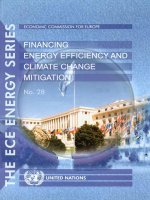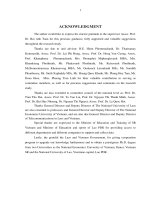Climate change mitigation in the buildings sector: the findings of the 4 Assessment Report of the IPCC
Bạn đang xem bản rút gọn của tài liệu. Xem và tải ngay bản đầy đủ của tài liệu tại đây (1.31 MB, 38 trang )
Climate change mitigation
in the buildings sector:
the findings of the
4th Assessment Report of the IPCC
Diana Ürge-Vorsatz
Coordinating Lead Author,
4th Assessment Report, IPCC
and
Professor and Director
Center for Climate Change and Sustainable Energy
Central European University
Outline
Mitigation in the buildings sector:
global and regional importance
Potential and costs of GHG mitigation in
buildings
Co-benefits of GHG mitigation in bldgs
Policies to foster carbon-efficiency
buildings
Conclusions
3CSEP
Mitigation in the buildings sector:
global and regional importance
Building sector: global importance
In 2004, in buildings were responsible for app. 1/3rd of global energyrelated CO2 (incl. indirect) and 3/5th of halocarbon emissions
GHG emissions from buildings in 2004
(in Gt CO2 equivalent)
total energy-related
CO2, 8.6 Gt, 81%
Energy-related
direct CO2,
3 Gt, 28%
CH4, 0.4 Gt, 4%
N2O,
0.1 Gt, 1%
Electricity-related
indirect CO2,
5.6 Gt, 53%
Halocarbons,
1.5 Gt, 14%
3CSEP
The buildings sector offers the largest low-cost
potential in all world regions by 2030
Estimated potential for GHG mitigation at a sectoral level in
2030 in different cost categories , transition economies
Gton CO2eq.
1
Cost categories* (US$/tCO2eq)
0.9
<20
<0
0-20
20-100
0.8
0.7
0.6
0.5
0.4
0.3
0.2
0.1
0
Buidlings
Industry
Agriculture
Energy supply
Forestry
Waste
Transport
* For the buildings, forestry, waste and transport sectors, the potential is split into three cost categories: at net negative costs, at 0-20
US$/tCO2, and 20-100 US$/tCO2. For the industrial, forestry, and energy suppy sectors, the potential is split into two categories: at costs
below 20 US$/tCO2 and at 20-100 US$/tCO2.
3CSEP
Estimated potential for GHG mitigation at a
sectoral level in 2030 in different cost
Gton CO2eq.
categories in developing countries
3.5
Cost categories (US$/tCO2eq)
3
<20
<0
0-20
20-100
2.5
2
1.5
1
0.5
0
Buidlings
Industry
Agriculture
Energy supply
Forestry
Waste
Transport
3CSEP
Constructed based on Chapter 11 results
Mitigation in the buildings sector:
opportunities
Globally app. 30% of all buildings-related CO2 emissions can be
avoided at a net benefit by 2020
New buildings can achieve the largest savings
As much as 80% of the operational costs of standard new buildings can
be saved through integrated design principles
Often at no or little extra cost
3CSEP
Buildings utilising passive solar construction
examples
Mitigation in the buildings sector:
opportunities
Globally app. 30% of all buildings-related CO2 emissions can be
avoided at a net benefit by 2020
New buildings can achieve the largest savings
As much as 80% of the operational costs of standard new buildings can
be saved through integrated design principles
Often at no or little extra cost
Hi-efficiency renovation is more costly, but possible
3CSEP
Case study:
Solanova in Hungary
300
250
kWh/m2a
200
-84%
150
100
50
Renewable Energy
Fossile Energy
0
Before
www.solanova.eu, not in IPCC report
SOLANOVA
Case study: savings by reconstruction,
Germany
Before reconstruction
over 150 kWh/(m²a)
Reconstruction according
to the passive house
principle
-90%
15 kWh/(m²a)
Mitigation in the buildings sector:
opportunities
Globally app. 30% of all buildings-related CO2 emissions can be
avoided at a net benefit by 2020
New buildings can achieve the largest savings
As much as 80% of the operational costs of standard new buildings can
be saved through integrated design principles
Often at no or little extra cost
Hi-efficiency renovation is more costly, but possible
The majority of technologies and know-how are widely available
Net zero energy/emission, or even negative energy buildings are
dynamically growing
3CSEP
3CSEP
WBCSD:
“Our vision
A world where buildings
consume zero net energy
Energy Efficiency in Buildings”
WBCSD: “Our target is all buildings, everywhere
The EEB project will map out the transition to a 2050 world in which
buildings use zero net energy. They must also be aesthetically
pleasing and meet other sustainability criteria, especially for air quality,
water use and economic viability.” (not in IPCC report)
Co-benefits of GHG mitigation in
buildings
Co-benefits of GHG mitigation in
buildings 1.
Co-benefits are often not quantified, monetized, or
identified
Overall value of co-benefits may be higher than value of
energy savings
A wide range of co-benefits, including:
Reduced morbidity and mortality
App. 2.2 million deaths attributable to indoor air pollution each
year from biomass (wood, charcoal, crop residues and dung) and coal
burning for household cooking and heating, in addition to acute
respiratory infections in young children and chronic pulmonary disease
in adults
Gender benefits: women and children also collect biomass fuel, they
can work or go to school instead
3CSEP
Co-benefits of GHG mitigation in
buildings 2.
Improved social welfare
Fuel poverty: In the UK, about 20% of all households live in fuel poverty. The
number of annual excess winter deaths is estimated at around 30 thousand annually
in the UK alone.
Energy-efficient household equipment and low-energy building design helps
households cope with increasing energy tariffs
Employment creation
“producing” energy through energy efficiency or renewables is more employment
intensive than through traditional ways
a 20% reduction in EU energy consumption by 2020 can potentially create 1 mil new
jobs in Europe
new business opportunities
a market opportunity of € 5–10 billion in energy service markets in Europe
Reduced energy costs will make businesses more competitive
Others:
Improved energy security, reduced burden of constrained generation capacities,
Increased value for real estate, Improved energy services (lighting, thermal comfort,
etc) can improve productivity, Improved outdoor air quality
3CSEP
Although improving building efficiency is often
profitable, investments are hindered by
barriers
Although there are large cost-effective investments to be
made, market barriers often hinder that they are
captured by market forces
Including misplaced incentives, distorted energy price/tax
regimes, fragmented industry and building design process,
limited access to financing, lack of information and awareness
(of the benefits), regulatory failures, etc.
These barriers are perhaps the most numerous and
strongest in the buildings sector
Therefore, only strong and diverse policies can
overcome them to kick-start and catalise markets in
capturing the potentially cost-effective investments
3CSEP
Policies to foster carbonefficiency buildings
Method:
global review of ex-post policy evaluations
Over 80 ex-post policy evaluation studies were reviewed from over
52 countries
20 policy instruments analysed
3CSEP
The impact and effectiveness of various policy instruments
Part 1: Control and regulatory mechanisms- normative instruments
Policy
instrument
Country
examples
Appliance
standards
EU, US, JP,
AUS, Br,
Cn
Building
codes
SG, Phil,
Alg, Egy,
US, UK, Cn,
EU
Procurement
regulations
US, EU, Cn,
Mex, Kor,
Jp
Energy
efficiency
obligations
and quotas
UK, Be, Fr,
I, Dk, Ir
Effectivene
ss
Energy or emission reductions for
selected best practices
Costeffective
ness
Cost of GHG emission
reduction for selected
best practices
High
Jp: 31 M tCO2 in 2010;
Cn: 250 Mt CO2 in 10 yrs
US: 1990-1997: 108 Mt CO2eq, in 2000: 65MtCO2 =
2.5% of el.use,
Can: 8 MtCO2 in total by 2010,
Br: 0.38 MtCO2/year
AUS: 7.9 MtCO2 by 2010
High
AUS: -52 $/tCO2 in 2020,
US: -65 $/tCO2 in 2020;
EU: -194 $/tCO2 in 2020
Mar: 0.008 $/kWh
High
HkG: 1% of total el.saved;
US: 79.6 M tCO2 in 2000;
EU: 35-45 MtCO2, up to 60% savings for new bdgs
UK: 2.88 MtCO2 by 2010, 7% less en use in houses
14% with grants& labelling
Cn: 15-20% of energy saved in urban regions
Medium
NL: from -189 $/tCO2 to -5
$/tCO2 for end-users,
46-109 $/tCO2 for Society
High
Mex: 4 cities saved 3.3 ktCO2eq. in 1year
Ch: 3.6Mt CO2 expected
EU: 20-44MtCO2 potential
US:9-31Mt CO2 in 2010
High/
Medium
Mex: $1Million in purchases
saves $726,000/year;
EU: <21$/tCO2
High
Flanders: -216$/tCO2 for
households, -60 $/tCO2 for
other sector in 2003.
UK: -139 $ /tCO2
High
UK: 2.6 M tCO2/yr
3CSEP
The impact and effectiveness of various policy instruments
Part 2: Regulatory- informative instruments
Policy instrument
Country
examples
Mandatory
labelling and
certification
programs
US, Jp,
CAN, Cn,
AUS, Cr,
EU, Mex,
SA
Mandatory audit
programs
US; Fr,
NZL,
Egy,
AUS, Cz
Utility demandside management
programs
US, Sw, Dk,
Nl, De, Aut
Effectiveness
Energy or emission reductions
for selected best practices
Costeffective
ness
Cost of GHG emission
reduction for selected
best practices
High
AUS: 5 Mt CO2 savings 1992-2000,
81Mt CO2 2000-2015,
SA: 480kt/yr
Dk: 3.568Mt CO2
High
AUS:-30$/t CO2 abated
High,
variable
US: Weatherisation program: 22%
saved in weatherized households
after audits (30%
according to IEA)
Medium/Hi
gh
US Weatherisation
program: BC-ratio:
2.4
High
US : 36.7 MtCO2in 2000,
Jamaica: 13 GWh/ year,
4.9% less el use = 10.8 ktCO2
Dk: 0.8 MtCO2
Tha: 5.2 % of annual el sales 19962006
High
EU: - 255$/tCO2
Dk: -209.3 $/tCO2
US: Average costs
app. -35 $/tCO2
Tha: 0.013 $/kWh
3CSEP
The impact and effectiveness of various policy instruments
Part 3: Economic and market-based instruments
Policy instrument
Country
examples
Energy
performance
contracting/
ESCO support
De, Aut,
Fr, Swe,
Fi, US,
Jp, Hu
Cooperative/
technology
procurement
De, It, Sk,
UK, Swe,
Aut, Ir,
US,Jp
Energy efficiency
certificate
schemes
It, Fr
Kyoto Protocol
flexible
mechanisms
Cn, Tha,
CEE (JI
&AIJ)
Costeffective
ness
Cost of GHG emission
reduction for selected
best practices
High
Fr, S, US, Fi: 20-40% of
buildings energy saved;
EU:40-55MtCO2 by 2010
US: 3.2 MtCO2/yr
Cn: 34 MtCO2
Medium/
High
EU: mostly at no cost,
rest at <22$/tCO2;
US: Public sector:
B/C ratio 1.6,
Priv. sector: 2.1
High/Medi
um
US: 96 ktCO2
German telecom company:
up to 60% energy savings
for specific units
Medium/
High
US: - 118 $/ tCO2
Swe: 0.11$/kWh
(BELOK)
High
Fr: 0.011 $/tCO2
estimated
Low
CEE: 63 $/tCO2
Estonia: 41-57$/tCO2
Latvia: -10$/tCO2
Effectiveness
Energy or emission reductions for
selected best practices
High
Low
I: 1.3 MtCO2 in 2006,
3.64 Mt CO2 eq by 2009 expected
CEE: 220 K tCO2 in 2000
Estonia: 3.8-4.6 kt CO2 (3
projects)
Latvia: 830-1430 tCO2
3CSEP









